Issue Archive
Table of Contents
BLOOD COMMENTARIES
SPECIAL REPORT
Guiding the global evolution of cytogenetic testing for hematologic malignancies
In this Special Report, Akkari and colleagues discussed the future of cytogenetic testing for hematologic malignancies in the context of advanced cytogenetic techniques as well as next-generation sequencing and whole genome sequencing. They discussed the role of clinical, technical, and economic factors in determining the path forward for providing an affordable state-or-the-art diagnostic approach.
REVIEW ARTICLE
The journey of neutropoiesis: how complex landscapes in bone marrow guide continuous neutrophil lineage determination
Overbeeke et al reviewed our current understanding of the process of neutrophil ontogeny in the bone marrow. The traditional models have changed in the face of better molecular characterization of cell fate decisions, and a broader understanding of the intrinsic and extrinsic signals that regulate neutrophil proliferation, maturation, and clearance.
HOW I TREAT
How I treat refractory/relapsed hairy cell leukemia with BRAF inhibitors
Falini and colleagues reviewed the treatment of relapsed/refractory hairy cell leukemia with vemurafenib with reference to 3 illustrative cases.
CLINICAL TRIALS AND OBSERVATIONS
Safety and efficacy of tisagenlecleucel in primary CNS lymphoma: a phase 1/2 clinical trial
Clinical Trials & Observations
Relapsed/refractory primary central nervous system (CNS) lymphoma (PCNSL) has a terrible prognosis. Frigault et al reported encouraging results with CAR-T cell therapy with tisangenlecleucel in 12 patients with relapsed PCNSL. CAR-T cells expanded in the periphery and transited to the CNS. The 58% response rate, including 50% complete responses and 43% sustained responses, with manageable episodes of cytokine release syndrome and neurotoxicity suggest this is a safe and effective therapy for this otherwise poorly responsive disease.
IMMUNOBIOLOGY AND IMMUNOTHERAPY
PIM2 kinase has a pivotal role in plasmablast generation and plasma cell survival, opening up novel treatment options in myeloma
LYMPHOID NEOPLASIA
Obinutuzumab plus lenalidomide in advanced, previously untreated follicular lymphoma in need of systemic therapy: a LYSA study
Clinical Trials & Observations
Bachy and colleagues reported on efficacy and safety results of a phase 2 trial of the DNA-damaging chemotherapy-free regimen of obinutuzumab and lenalidomide for the initial therapy of patients with advanced follicular lymphoma. Results were impressive, with a complete response rate of 80% and 3-year progression-free and overall survival of 82% and 94% respectively.
MYELOID NEOPLASIA
Molecular characterization of mutant TP53 acute myeloid leukemia and high-risk myelodysplastic syndrome
Grob et al performed next-generation sequencing on 2200 samples from patients with acute myeloid leukemia (AML) and myelodysplastic syndrome with excess blasts (MDS-EB) to assess the prognostic impact of TP53 mutation. Mutant TP53 occurred in 10.5% of AML/MDS-EB patients with concurrent mutations in half of them. All patients with TP53 mutations had poor outcomes, with a 2-year survival of only 12.8%, with no difference in outcome between AML and MDS-EB. The authors proposed that TP53-mutated AML/MDS-EB should be considered a distinct, single disease entity.
PLATELETS AND THROMBOPOIESIS
RED CELLS, IRON, AND ERYTHROPOIESIS
Plasma biomarkers of hemoglobin loss in Plasmodium falciparum–infected children identified by quantitative proteomics
Clinical Trials & Observations
Severe malarial anemia, a major cause of mortality in young children with Plasmodium falciparum (Pf), is attributed to hemolysis of both uninfected and infected erythrocytes as well as decreased erythropoiesis. Mahamar and colleagues performed proteomics in 9 Pf-infected children with and without anemia and identified elevated 20S proteasome levels and decreased IGF-1 levels in children with anemia, confirmed in a validation cohort. They proposed that 20S proteasome promotes hemolysis by digestion of erythrocyte membrane proteins while decreased IGF levels may contribute to decreased erythropoiesis.
THROMBOSIS AND HEMOSTASIS
Granulocyte microvesicles with a high plasmin generation capacity promote clot lysis and improve outcome in septic shock
Cointe et al reported that neutrophil-derived microvesicles (MV) can ameliorate hypercoagulability in septic shock. They showed that a subset of neutrophil-derived MVs are enriched with urokinase (uPA) that can lyse thrombi. Injection of uPA-rich MVs from neutrophils improved mouse survival from septic shock and reduced microthrombi in vital organs, suggesting that despite the ability of neutrophils to mediate tissue damage in sepsis, they also have a role in down-regulating the prothrombotic phenotype.
TRANSPLANTATION
Alloreactive T cells deficient of the short-chain fatty acid receptor GPR109A induce less graft-versus-host disease
LETTER TO BLOOD
BLOOD WORK
-
Cover Image
Cover Image
![issue cover]()
Intense labeling of PIM2 kinase in tumor plasma cells in a myeloma bone marrow biopsy specimen. CD138 is shown in red, PIM2 in green, and DAPI in blue. See the article by Haas et al on page 2316.
- PDF Icon Front MatterFront Matter
- PDF Icon Table of ContentsTable of Contents
- PDF Icon Editorial BoardEditorial Board
Advertisement intended for health care professionals
Email alerts
Advertisement intended for health care professionals


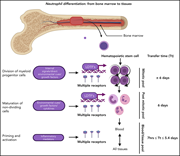
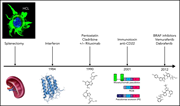
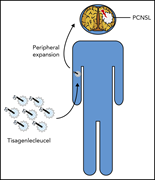




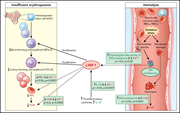
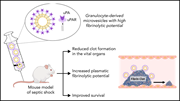
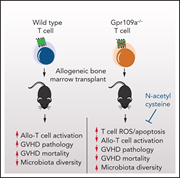

No CNS sanctuary for lymphoma from CAR T
Clinical Trials & Observations